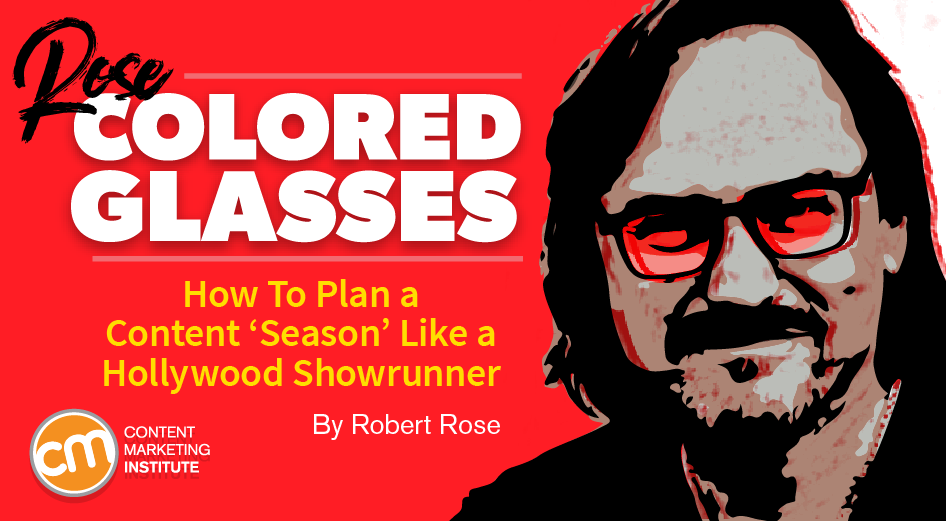MARKETING
How To Plan a Content ‘Season’ Like a Hollywood Showrunner

What should we talk about in our content?
This question plagues many content marketing teams. The brand message might be crystal clear. The products have clear value propositions and differentiators. The marketing team understands its paid media schedule, the agency is working out the creative elements, and the PR team is readying news around new hires, products, and partnerships.
The content team, however, struggles with topics.
Content marketers often approach this by getting a meeting together to brainstorm.
Here’s how that usually goes:
Someone from the demand generation team suggests creating a list of all the questions buyers might ask about the company’s particular approach.
The product marketing manager likes that idea and says, “We could create articles answering those questions and then sprinkle in how we solve those challenges.”
The brand marketing manager says, “Why don’t we write some posts about our new brand mission and how our products and services are helping solve climate change?” They punctuate their suggestion by throwing a copy of Simon Sinek’s Start With Why onto the table.
The product marketing manager chimes in: “Yes, and we could sprinkle in a bit about how our product solves those challenges.”
“I know,” says someone from PR, “let’s write posts that feature profiles of our executives and their thought leadership in the market.”
The brand marketing manager nods in appreciation. “Yes, great idea. That’s storytelling. It’s got a hero.”
The product marketing manager stands up and says, “I like it. And maybe the executives could talk a little about how our product solves difficult challenges.”
Only the content marketing team sits silently, looking down at their notebooks. They’ve taken exactly zero notes.
The pizza arrives, and the meeting ends. The brand marketing manager says, “I don’t know what you all were so worried about. We’ve got tons of things to talk about.”
HANDPICKED RELATED CONTENT:
Finding the bigger story
I work with content marketing teams for brands all over the world. I’ve noticed that when teams struggle to find a focused editorial direction for their content platform, it’s usually because they haven’t set the foundation for a bigger story.
Without a focused story (or stories), any alternative feels valid. As a result, their blog feels like an ad hoc collection of answers to FAQs. The resource center is a random collection of promotional materials and case studies. Their webinar program is just a catch-all featuring whoever is available to talk about how their product solves things.
I’ve discussed the importance of planning before. But within that planning process description lies the assumption that the relevant teams have met to decide on a bigger story to use as a foundation for planning.
But what if that hasn’t happened yet? How do you go about finding that bigger story?
As it turns out, you can learn a lot from media operations.
An overarching story helps #Content end the struggle to find editorial direction, says @Robert_Rose via @CMIContent. Click To Tweet
What TV showrunners know
Television series are created by teams representing all aspects of producing great content. There are writers, directors, actors, editors, production specialists, and so on.
Similarly, multiple teams come together when a brand’s content marketing team embarks on a thought leadership program or content marketing initiative. These teams also rely on diverse experts: writers, designers, subject matter experts, and others.
Both teams face similar problems. This chaotic, creative process requires participation from many different groups.
How do you align all those disciplines and develop a cohesive story?
The question in Hollywood: “What’s the story?”
The question in content marketing: “What’s the story?”
Here is an approach that I’ve seen work in both situations.
Find the story – then plan it out over a season
The first thing I advise content marketing teams to do is this: Find the focus for a story they want to tell over a specific period on specific platforms.
I’ve talked before about the approach of using your brand story to find your content stories and even rebooting your story from content you’ve written before.
But another (often overlooked) aspect of this first step is to plan how your story will play out over time.
Hollywood showrunners do this by bringing all the writers together to generate ideas about episodes and character development arcs.
Content marketers can learn from this. Why not bring the team together to plan out a bunch of ideas that would help you tell a complete story?
Think of it like planning out an entire season of content. For example, you might theme your editorial strategy for the coming quarter, build it around a curriculum, or even align it to the seasonal calendar.
With this approach, you’ll end up with more than a list of titles of articles, posts, or assets to create. You’ll have planned different chapters (or episodes) of a broader story that may end up as many kinds of digital assets for different platforms.
Think of #content planning like plotting out an entire TV show season, says @Robert_Rose via @CMIContent. Click To Tweet
Outline the chapters – then create your packages
The next step for showrunners is to create outlines of the episodes that make up the show’s season. These detailed story outlines help the other professionals understand when things like specific locales, guest actors, or bigger budgets may be necessary.
In content marketing, outlining your story’s upcoming chapters can help you decide which formats would work best. For example, you may decide that for the initial “episode,” you want to create an article and a blog post. But you want to combine the second episode with a white paper, a webinar, and a blog post.
Deciding on these packages separates the content development from the digital assets you’ll package them into. Creators get a heads-up that they’ll need to write the content for the various interfaces selected to optimize accordingly. Designers will have a complete portfolio of content that they can use to create all the assets needed.
Planning at this level of detail enables the true benefits of a content calendar. All the teams can see plans for the story to unfold and all the different platforms where it will be told. They may start to see that the content season will meet their needs – reducing the demand for ad hoc assets.
Planning a full season of #Content lets internal teams see how the story will meet their needs, says @Robert_Rose via @CMIContent. Click To Tweet
Create the content – not necessarily the assets
In the next stage, Hollywood showrunners assign the writing for the various episodes. All the writers know the story and the outlines for upcoming episodes so that the showrunner can choose the optimal writer for each episode.
A content marketing team might assign the first couple of episodes to one writing team, then assign another team to take up the project for episode three.
Think of it like this: If you’ve mapped out your entire story, you and the team know what’s coming. You can work on the chapters simultaneously, knowing that things can change if needed. More importantly, this approach lets you work ahead instead of constantly chasing deadlines.
The key here is to write the content, not necessarily the digital assets. The goal is to have the stories created well ahead of the deadlines in your story schedule. For example, one successful content marketing team I’ve worked with makes a “content digest” for each of their episodes. This single document includes all the written content for all the places it will live (e.g., promotional ads, blog posts, social posts, long-form articles, etc.) and a creative brief for all the asset elements the content will be packaged into. Once the content reaches production, the creative team creates all the design containers simultaneously.
Approaching content separately from production means you may have 10 or more episodes ready to go before the first one even publishes. This lets you adjust the production schedule as you learn from each episode as it rolls out. If episode 1 goes exceedingly well, for example, you can make changes to episode 6. You’ve seen this in action with your favorite series. A character becomes a fan favorite in episode 1 – and suddenly has much more screen time by episode 5.
Additionally, it’s a much more efficient process. You know episode 3 (which is already written) will need a thought leadership paper, a webinar, and a blog post. Fantastic. Now, you know how to help the production team schedule their efforts. And, you have the room to change if the first webinar is so successful that you want to add more.
One story to rule (out) them all
Setting the bigger story in place and working the plan through cross-functional teams does more than give you production efficiency. It also provides focus. You can weigh any proposed idea against something important: the bigger story.
So, when that inevitable “Yes, and can we sprinkle in a little more about how our product solves that challenge” comment comes in?
You can look down at your copious notes and say, “I’m sorry, that’s not part of this particular story.”
Remember, it’s your story. Tell it well.
Get Robert’s take on content marketing industry news in just five minutes
Watch previous episodes or read the lightly edited transcripts.
Cover image by Joseph Kalinowski/Content Marketing Institute



















You must be logged in to post a comment Login